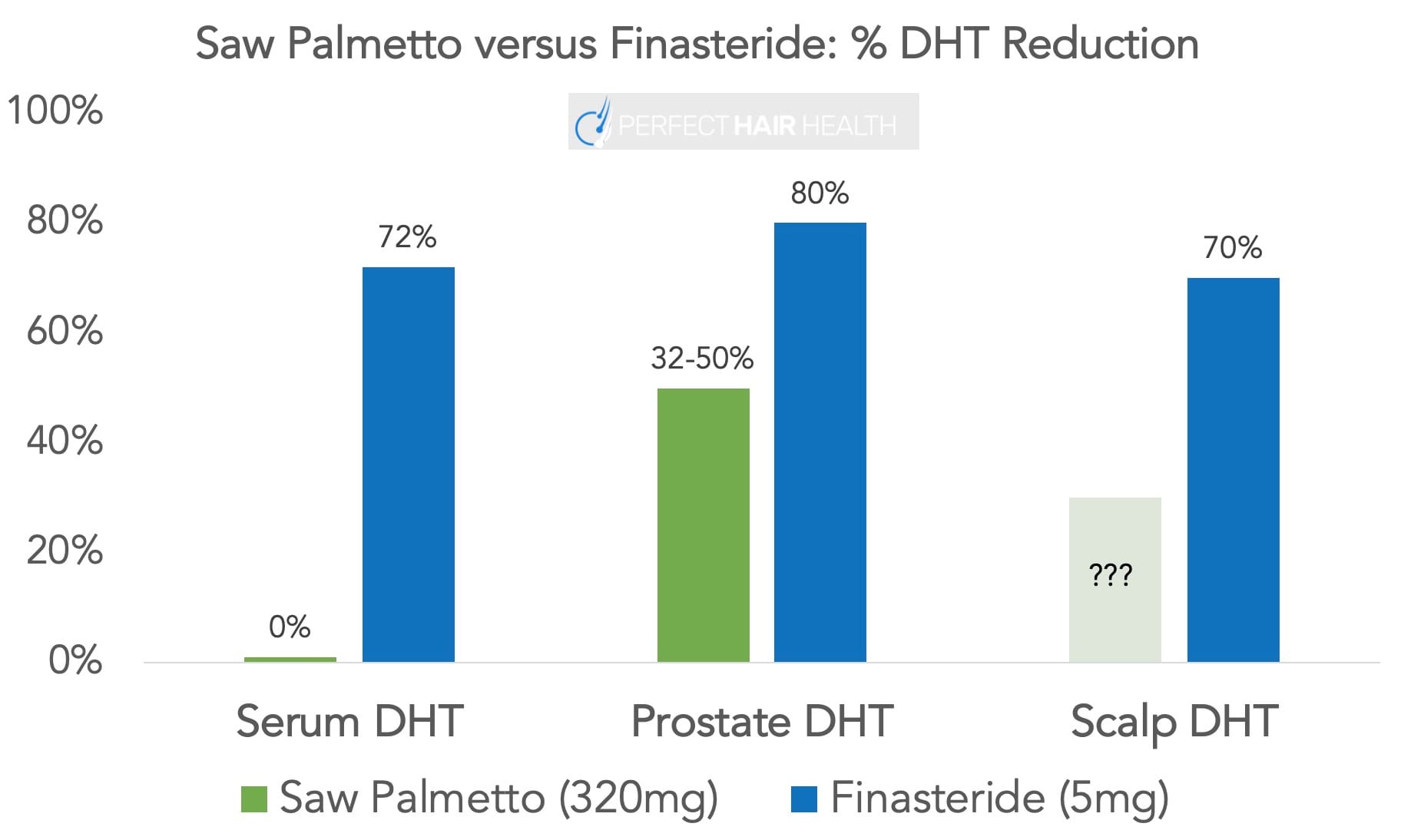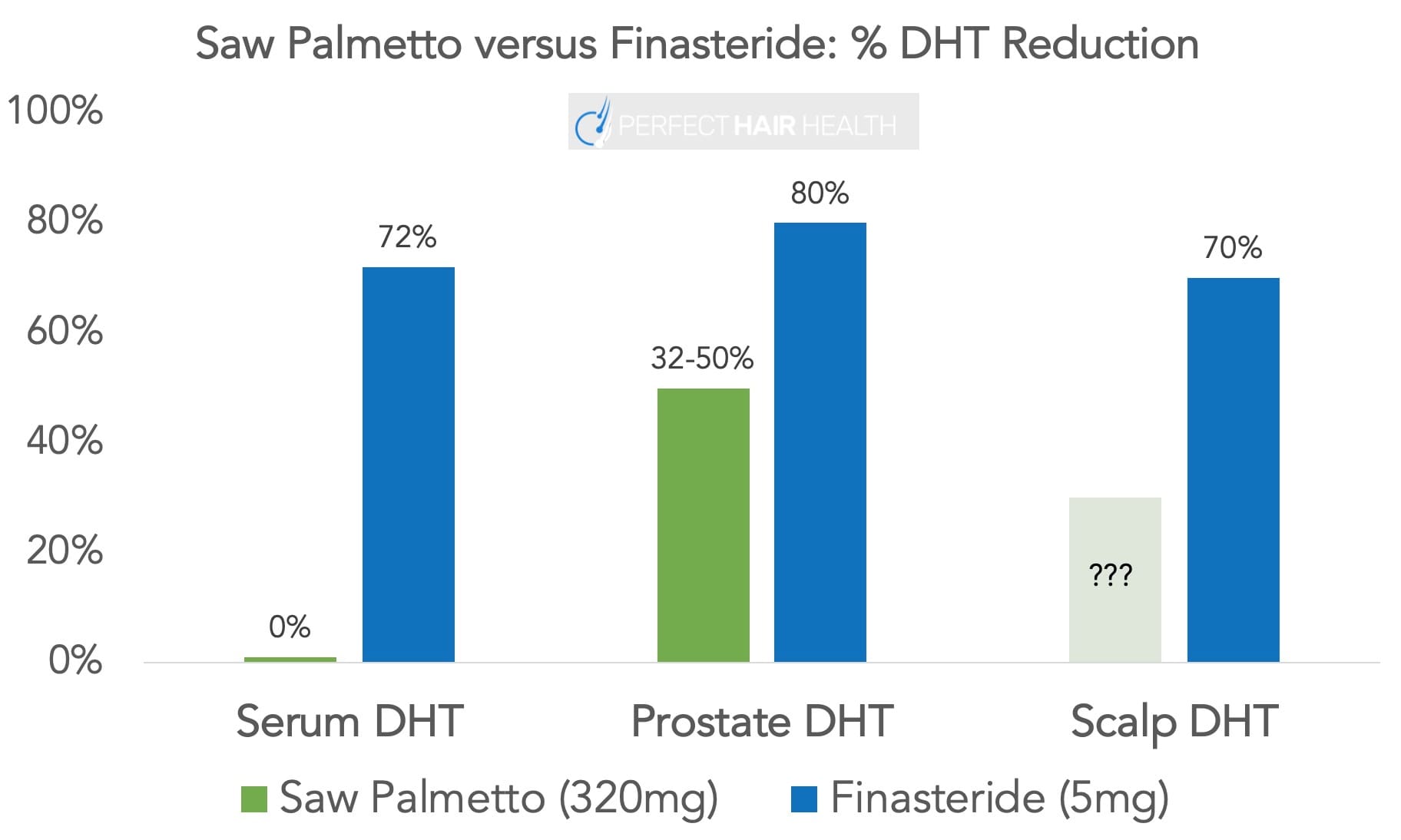Saw palmetto for hair growth: does it stack up to finasteride?
Saw palmetto is often touted as nature’s finasteride. This herbal extract reduces levels of the hormone dihydrotestosterone (DHT). For this reason, it’s clinically demonstrated to improve hair growth in men with androgenic alopecia (AGA).
But is saw palmetto as effective as finasteride?
Not quite. In fact, a closer look into the research on saw palmetto reveals that taking this supplement also comes with risks.
That’s not to say that saw palmetto is ineffective. But if you’re going to opt for saw palmetto over finasteride, you’re going to want to weigh its benefits and risks. Specifically, you’re going to want to know how saw palmetto compares to finasteride in terms of its (1) ability to reduce DHT, (2) ability to regrow hair, and (3) reported side effects.
This Quick Win dives into the details (and answers). The bottom line: saw palmetto isn’t as powerful as finasteride, but it also comes with some upsides that may make it a better option, at leaast for certain hair loss sufferers.
Note: Quick Wins are short articles focused on answering one question about hair loss. Given their specificity, these articles are written in a more scientific tone. If you’re new to hair loss research, start with our long-form articles.
What is saw palmetto?
Saw palmetto is a palm plant native to warm humid climates (Florida).
Saw palmetto plant
Thirty years ago, researchers discovered that certain polyphenol and lipid extracts of saw palmetto could reduce the activity of type II 5-alpha reductase – an enzyme our bodies use to make the hormone dihydrotestosterone (DHT).
DHT is the main hormone implicated in pattern hair loss, also called androgenic alopecia (AGA). And interestingly, the popular hair loss drug finasteride (Propecia®) reduces that same enzyme – type II 5-alpha reductase – to lower DHT levels and improve pattern hair loss outcomes in ~80% of men trying the drug.
Unfortunately, finasteride use is also associated with sexual side effects. This scares a lot of men away from trying the drug. It also leads many of them to wonder…
“If I use saw palmetto instead of finasteride, can I still regrow hair while also reducing my risk of side effects? After all, saw palmetto is natural, and natural often means safer.”
For starters, anything branded as “natural” isn’t always safer. Many natural supplements sold through Amazon and tested by third parties have been found to contain dangerous levels of heavy metals. Moreover, many popular natural extracts – i.e., green tea extract – have been associated with hepatic failure due to the metabolic demands these extracts can place on our livers. (For more information, see my master class).
In any case, if we’re to answer the question, “Is saw palmetto as effective as finasteride?”, we’ll need to evaluate saw palmetto versus finasteride in terms of its (1) expected hair regrowth, and (2) risk of side effects.
The rest of this Quick Win does just this.
Saw palmetto vs finasteride: hair regrowth
“Hair regrowth” is a non-specific term, and most clinical studies on pattern hair loss define this term differently:
- Reductions to hair shedding
- Improvements to anagen:telogen ratios
- Increases in non-vellus hair counts
- Global photography assessments
…the list goes on.
That’s why, whenever we’re diving in studies on hair loss, we standardize the term “hair regrowth” into two categories:
- Response Rate. This is the percentage of people receiving treatment who see a slowing, stopping, or reversal in their hair loss. After all, simply slowing down the progression of AGA is a win for most hair loss sufferers.
- Regrowth Rate. This is the percent change in terminal (i.e., non-vellus) hair counts before and after treatment. We use this metric because it’s best out there in terms of translation to visual improvements. Increases to vellus hair counts (i.e., small, wispy, white hairs) just don’t show up in photographs, so we don’t count those.
So, if we summarize the data on saw palmetto versus finasteride, how do these two interventions compare? (1) (2)
|
Saw Palmetto (320mg) |
Finasteride (1mg) |
|
| Response Rate | 60%; dependent on the dose and delivery (supplement or topical) | 80-90% |
| Regrowth Rate | 0-10%; potentially higher if used alongside other therapies | 10%, alongside thickening of miniaturizing hair |
The key takeaway: compared to finasteride, saw palmetto has a lower response rate and regrowth rate. And when we look at the individual studies that constitute these aggregated estimations, things look a little bleak.
To date, there’s only one clinical study directly comparing saw palmetto versus finasteride for the treatment of androgenic alopecia. The investigation team randomized 100 men with androgenic alopecia into two groups. They gave one group 320mg of saw palmetto and the other group 1mg of finasteride – every day, for two years. (3)
The results? After 24 months, 68% of finasteride users saw hair regrowth, while only 38% of men taking saw palmetto saw hair regrowth. Moreover, investigators noted that in the saw palmetto group, hair regrowth only occurred in the crown (i.e., vertex), and that the magnitude of regrowth was significantly less than finasteride.
In other words, saw palmetto achieves half the response rate of finasteride, and that if regrowth does occur, it’s not nearly as impressive as what finasteride achieves.
Having said that, it’s not all bad news. That same study also demonstrated that 45/50 men in the saw palmetto group saw a stop in hair loss over the two years that they took it. So, in this one study, saw palmetto showed a response rate of 90%.
This means it’s not a complete stretch to say that most men taking 320mg of saw palmetto daily should see an improvement in their pattern hair loss. It’s just that this improvement won’t be anywhere near on-par what is achievable with finasteride.
Why isn’t saw palmetto as effective as finasteride?
This likely has to do with the ways in which saw palmetto reduces DHT, and the amount of DHT that saw palmetto reduces.
Finasteride is a synthetic azosteroid. It reduces DHT by competing with (and binding to) a coenzyme that our bodies use to make type II 5-alpha reductase – the enzyme that converts free testosterone into DHT.
Conversely, saw palmetto competitively and non-competitively inhibiting type II 5-alpha reductase, reducing the binding of DHT to androgen receptors, and increasing the conversion of DHT to a weaker metabolite called androstanediol (4).
The long-story short is that these factors, along with differences in the half lives of both finasteride and saw palmetto, lead to differences in their abilities to lower DHT.
For reference, see this graph on the DHT-reducing capabilities of both saw palmetto and finasteride, as organized by different tissue sites.
The bottom line: saw palmetto is about half as effective as finasteride because it just doesn’t reduce as much DHT.
What about side effects?
At this point, we’ve really only evaluated half of the question: is saw palmetto as effective as finasteride?
In terms of response rates and regrowth rates, the answer is no. But can saw palmetto make up for its lower efficacy by being a safer long-term supplement for hair loss sufferers?
Maybe.
Saw palmetto: risk of adverse events
Long-term clinical studies show that saw palmetto’s overall rate of side effects is just 2%. Moreover, if side effects do occur, they’re relegated more so to gastrointestinal distress than to sexual dysfunction. Even better, many studies on saw palmetto show no change in libido; some studies show improvement to sexual health (at least for men with enlarged prostates). (5) (6) (7)
Finasteride: risk of adverse events
The “Yelp effect” is a phenomenon where patrons of a business are far more likely to leave a review if their experience was negative rather than positive. Finasteride is a drug that suffers from the Yelp effect, meaning that its sexual side effects are often overstated and amplified online.
Having said that, side effects do occur. Moreover, the self-assessment questionnaires filled out by participants in large-scale clinical trials for finasteride were worded in such a way where under-reporting certain side effects were more likely than not (but that’s for another article).
In any case, finasteride use does come with a heightened risk of side effects. Depending on which study you cite, between 1% and 25% of finasteride users will report issues ranging from brain fog to depression to sexual dysfunction. (8) (9) Moreover, when side effects are reported, they seem to be of higher magnitude versus saw palmetto.
The bottom line:
- Finasteride’s side effects are likely overstated online and understated in the literature
- Compared to saw palmetto, finasteride likely leads to side effects that are (1) of higher incidence, and (2) more severe
Saw palmetto or finasteride: which one is right for you?
It depends on your risk tolerance for side effects, and whether you plan on combining saw palmetto with other treatments, therapies, or procedures to make up for its lower response rates and regrowth rates.
There’s evidence that supplemental + topical saw palmetto, alongside other ingredients, might lead to better hair loss outcomes than just supplemental saw palmetto. Moreover, combining saw palmetto with massaging, microneedling, platelet-rich plasma therapy, or other interventions might help mitigate its lower efficacy.
Having said that, making these choices will depend entirely on someone’s needs, preferences, and unique hair loss situation.
Anything else to know?
Unlike finasteride, saw palmetto isn’t standardized. Serenoa repens growing conditions, extraction methods, and manufacturing practices can all impact the composition, bioavailability, and absorption of each saw palmetto supplement. In fact, these differences might explain the variances in response rates and regrowth rates seen across saw palmetto studies.
So, if you’re looking for a more comprehensive guide on how to use saw palmetto – including recommendations for dosages, extraction practices, and combinations therapies – see our saw palmetto ultimate guide here.
The bottom line
In order to evaluate whether saw palmetto is as effective as finasteride, we need to understand how the supplement compares in terms of (1) response rates, (2) regrowth rates, and (3) risk of side effects.
Saw palmetto isn’t as effective as finasteride in terms of its response rates or regrowth rates, but it also seems to cause fewer (and less severe) side effects. Because of this, making the choice to use saw palmetto over finasteride depends entirely on someone’s risk tolerance for side effects, as well as whether they plan on combining the supplement with other treatments, therapies, or procedures to make up for its less-impressive efficacy.
|
Saw Palmetto (320 mg) |
Finasteride (1 mg) |
|
| Response Rate | 60%; dependent on the dose and delivery (supplement or topical) | 80-90% |
| Regrowth Rate | 0-10%; potentially higher if used alongside other therapies | 10%, alongside thickening of miniaturizing hair |
| Side Effects | 2%; more relegated to gastrointestinal distress than sexual side effects | 1-25%; partly psychosomatic, but more severe than saw palmetto |
Otherwise, if you have any questions, please feel free to leave them in the comments section.

Rob English is a researcher, medical editor, and the founder of perfecthairhealth.com. He acts as a peer reviewer for scholarly journals and has published five peer-reviewed papers on androgenic alopecia. He writes regularly about the science behind hair loss (and hair growth). Feel free to browse his long-form articles and publications throughout this site.





Hello ! Could it be a good idea to start Saw Palmetto before finasteride to see if side effects are occuring? As gradually increasing the dose! Or do you think it’s dangerous to switch from one to the other ? Thanks in advance !
Hey Baptiste,
Saw palmetto is a much “gentler” 5-alpha reductase inhibitor versus finasteride. So, you could certainly try saw palmetto first and see how you respond.
As far as gradually increasing your dose of saw palmetto – the evidence we have (so far) is that 320mg daily of saw palmetto extract, standardized o 85-95 fatty acids, is no more effective than 960 mg daily (at least for treating BPH). So, there’s probably no need to gradually increase dosage after 320mg. In fact, if it were me, I’d probably just start at the 320mg dosage and see how you respond over the course of 1-2 months.
Best,
Rob
Hi what about progesterone cream instead of finasteride? Could it work the same way as the drug?
Hey Nathan,
There’s some mechanistic evidence that progesterone cream may act as a 5-alpha reductase inhibitor in skin tissues:
https://pubmed.ncbi.nlm.nih.gov/11558590/
https://pubmed.ncbi.nlm.nih.gov/1828548/
https://www.ncbi.nlm.nih.gov/pmc/articles/PMC7432488/
Oral progesterone-based therapies are also used in the treatment of female pattern hair loss. See our article here:
https://perfecthairhealth.com/hormonal-birth-control-hair-loss/
Having said that, I wouldn’t jump on a progesterone cream just yet. Progesterone-based medications have actually been considered as a male-based contraceptive measure. See this study here:
https://pubmed.ncbi.nlm.nih.gov/15707556/
The bottom line: we don’t really have any clinical data on using progesterone creams for hair growth in men. While mechanistic data supports this possibility, data also show that progesterone may also elicit similar side effects as finasteride. Without more evidence, I wouldn’t want to make myself the guinea pig here.
Best,
Rob
Has someone used a topical saw palmetto extract treatment yet?
HI There,
Looks like food based DHT blockers are not effective in preventing the pattern hair loss and if the hair loss is due to the DHT, there is no cure for it.
Thanks
Would it probably be better to start off with saw palmetto instead of finasteride? My hair has very slight recession that started almost ten years ago and if it has gotten any worse, it’s not by much. Id say I’m at a norwood 2, maybe 3, and only hair stylists noticed the slight recession. I would hope that saw palmetto would be the better choice and that I don’t need to significantly decrease DHT to keep my my hair. And tbh with you, id probably just let it go as opposed to any health risks of taking medication even if it takes more than 20 years or so for the hair loss to become noticeable. I’m just looking for healthier solutions to either stop the hair loss or just slow it down.
Would it be harmful to take both finasteride and saw palmetto at the same time? My thinking is if saw palmetto also helps with “ED” and other sexual dysfunctions could it help any percentage that finasteride has that side effect on your body/ blood flow.
Saw palmetto doesn’t have perfect mechanistic overlap with finasteride, so it’s entirely possible that saw palmetto + finasteride could have additional benefits to DHT reduction in scalp tissue versus finasteride alone. As far as using saw palmetto to combat ED-related side effects from finasteride – it’s really hard for me to weigh in here… because the side effect profile of saw palmetto changes (libido enhancing versus libido reducing) depending on the population being studies (Native Americans versus Europeans) – with no real evidence at a genetic level to explain the differences (suggesting the effect may be psychosomatic).